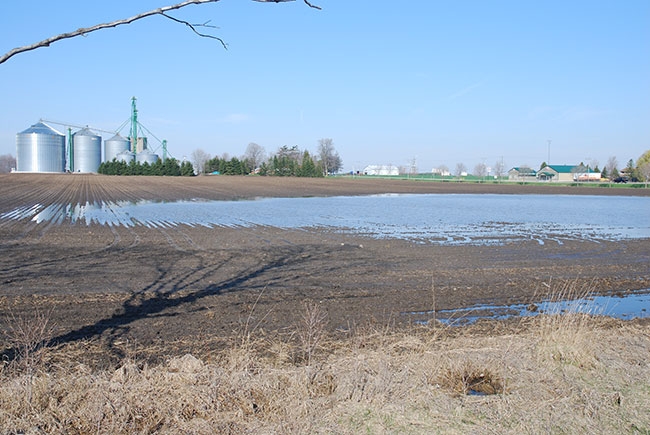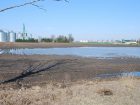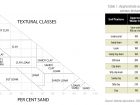
News
Understanding Water Holding Capacities
This is important information for irrigation farmers to decide when to irrigate, but it’s equally important for dryland farmers to understand their soil moisture conditions when deciding on crop input requirements.
April 6, 2018 By Ross H. McKenzie PhD P. Ag
 The amount of water the soil can retain depends on the structure of the soil. This is important information for irrigation farmers to decide when to irrigate
The amount of water the soil can retain depends on the structure of the soil. This is important information for irrigation farmers to decide when to irrigateUnderstanding soil texture
The amount of water the soil can retain depends on the texture of the soil. Soil texture refers to the proportion of different sized mineral particles in soil. The soil particles sizes are:
- Sand – 2.0 to 0.05 mm in size
- Silt – 0.05 to 0.002 mm in size
- Clay – <0.002 mm in size
Sand particles are the largest, silt is medium-sized and clay particles are the smallest. The relative proportions of sand, silt, and clay particles affect the pore sizes in soil, which affect the ability to hold and retain water. The proportions of sand, silt and clay determine classes of soil texture, shown on page 20.
Soils with higher amounts of clay have a greater abundance of small pores, and can retain more water than sandy soils that have larger sized pores. In sandy soils with larger pores, water is pulled downward and freely drained from soil by gravity.
Texture can be determined in the laboratory using mechanical analysis or can be estimated by wetting soil and kneading it between the thumb and forefinger using the hand-feel method.
Typically, soil texture can be divided into three main groups: course, medium and fine. Fine textured soils are: clay, silty clay, clay loam and sandy clay. Medium textured soils are: silty loam, sandy clay loam, and loam. Coarse textured soils are: sandy loam, loamy sand and sand. A loam textured soil typically has about 40 per cent of sand, 40 per cent of silt, and 20 per cent of clay.
To estimate the water holding capacity of a soil, the soil texture must be known.
Understanding soil water
A soil is at saturation point when all soil pores are filled with water after a saturating rain. Normally, within a day or two, gravity will pull away free water out of the soil profile and the remaining soil water content is then referred to as field capacity (FC).
Permanent wilting point (PWP) occurs when plants have extracted water to the level that cause plants to wilt and die. The soil water that is between field capacity and wilting point is called plant available water (PAW), which is the amount of water that plants can utilize. There is still a fair amount of water remaining in soil below permanent wilting point but the water is completely unavailable to plants. The figure above shows the relative differences of FC, PWP and PAW for clay loam (fine textured soil), loam (medium textured soil) and loamy sand (course textured soil) soil types.
Table 1 shows the approximate amount of plant available water different textured soils can hold. The values in table one are for soil textural classes in Alberta, which are applicable to the Prairies.
About 40 per cent of the plant available water in soil can be extracted by most crops, without incurring any water-limiting stress that would affect crop yield or quality. After about 40 to 50 per cent of the available water is used, it gradually becomes increasingly difficult for plants to extract water.
For irrigation farmers a critical term to understand is allowable depletion (AD), which is the per cent of water that can be removed from soil without significantly affecting crop yield or inducing crop water stress. This water is referred to as the readily available water (RAW). The AD of a soil is the per cent of water that can be removed from a soil between irrigation events without significantly stressing a crop or affecting crop yield or quality. The AD for most crops is about 40 per cent but is less for more sensitive crop such as potato and bean.
The total amount of water available to a crop depends on the water-holding capacity of a soil (table 1) and the effective root zone depth for each crop. The AD will vary with soil type, crop type, stage of crop growth and effective rooting depth of the crop. Allowable depletion is usually determined and expressed in mm per depth of soil. Effective rooting depth and irrigation water management is explained in more detail in “Managing your strategy” on page 27 of this issue.
Effects of moisture stress on crops
When a crop is in a moisture deficit condition during vegetative growth, the first effect is a reduction in the growth rate of leaves and stems. When soil moisture availability is limited, cell expansion and division within the plant slows down. The effect is that plants reduce the production of enzymes and proteins needed for growth.
As soil moisture deficiency increases, plant roots cannot take up enough water to meet transpiration needs. Crops respond by closing stomata. Plant leaves become less rigid and leaves exhibit wilting during mid-day heat. As air temperatures cool and solar radiation decreases later in the day and into the evening, plants recover from wilting as stomata open to meet transpiration needs.
When cereal crops begin wilting at mid-day, older leaves and tillers are gradually aborted, and stem elongation is reduced. When oilseed crops begin wilting, plants respond by abortion of older leaves, reduced stem elongation, reduced branching and flowers are aborted, which in turn reduce crop yield potential.
If soil moisture deficit becomes more advanced, wilting becomes more prolonged each day until plants reach a condition where recovery overnight does not occur, and plants completely senesce and die, which is the soil moisture permanent wilting point.
For more on soil and water, visit topcropmanager.com

